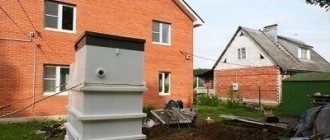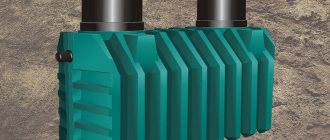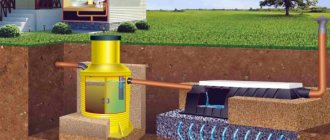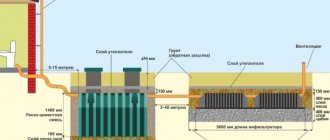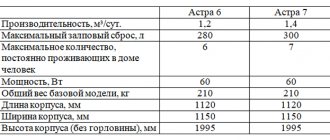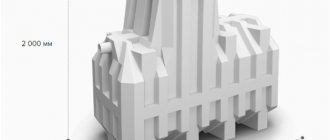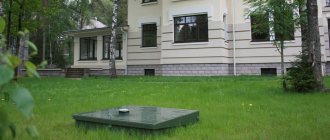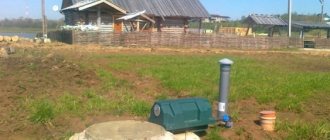General information
- The products of this company have proven themselves in the consumer market due to their price-quality ratio.
- The material used to make septic tanks is polypropylene.
- Polypropylene products do not deform at high temperatures.
- Have increased strength
- Capable of transporting and storing liquids at temperatures up to +140 degrees Celsius.
Septic tank models
| Septic tank | Volume, m3) | Productivity (l/day) | Dimensions (mm) | Weight (kg) |
| Klen-3N | 1 | 200 | 1200*880*910 | |
| Klen-5 | 1,5 | 450 | 1500*1100*1100 | 52 |
| Klen-5N | 1,5 | 450 | 1950*1100*1100 | 57 |
| Klen-7 | 2,5 | 750 | 1500*1500*1300 | 72 |
| Klen-7N | 2,5 | 750 | 1950*1500*1300 | 77 |
Explanations
- Maple -3, 5 and 7 can be installed at low groundwater levels.
- Maple – (N) stations are installed in any type of soil.
- A septic tank for a home with permanent residence differs in criteria from a septic tank for a summer residence.
- The volume of a septic tank for a country house with permanent residence is calculated using the formula
- Number of people * per 200 liters (statistical liquid consumption) * 3. According to SNiP, water must be treated at the station for at least 14 days.
Example
5 people
5*200*3=3000l
A septic tank with a volume of 3 m3 is enough
For a summer residence, the volume of the septic tank is determined by other indicators.
A person consumes 90-100 liters of water per day
Accordingly, for a house with temporary residence of 5 people, a septic tank with a volume of 1.5 m3 is suitable
5*100*3=1500
Positive traits
Series 5 and 5N are not too demanding on maintenance - it is enough to remove sediment once every 2 years using a fecal pump or a sewer truck. Among other advantages it is worth highlighting:
- Operational durability
- Full autonomy (Klen 5)
- Simplicity of design
- Minimal Maintenance
- Absolute tightness
The unique technology, along with the simple design of the septic tank, allows the equipment to be used for half a century. It is recommended to trust the installation of a septic tank exclusively to specialists, however, if necessary or desired, you can handle the installation of an autonomous sewer system yourself. Thanks to the sealed design, the environmental impact is zero.
The materials used in the production of septic tanks provide the final product with resistance to temperature changes. There is also no need to connect to the central sewer system. The complete energy independence of the wastewater disposal system attracts the attention of summer residents and owners of country houses. The solution under consideration is ideal against the backdrop of septic tanks made of concrete rings, expensive deep biological treatment systems, storage tanks and cesspools.
DIY installation
It is worth considering that for clay soil and high groundwater level, the Maple -3.5 and 7 septic tank is not suitable. It is better to opt for models of category “H”
Before you begin installation, you should decide on the choice of location. There are practically no restrictions for local treatment stations. The main requirement is 5 meters from the house and 30 from the water source.
For conventional septic tanks, more rules must be followed:
- 5 meters from the house
- 30 meters from a well or well
- 3 meters from trees
- 5 meters from the road
- 10 meters from a body of water (river, stream)
Installation of a septic tank:
- A pit is being dug
- The bottom is covered with a ten-centimeter layer of sand, compacted and leveled.
- A trench is dug for the pipes. Be sure to maintain a slope of 2-3 cm per linear meter for gravity flow of wastewater.
- A septic tank is being installed
- Ventilation is provided. Installation can be carried out using any of the methods listed above. Directly on the sewer pipe in the house
- On a septic tank
- A diversion is made to the fence
- Installed on the house from the street side.
- For Maple 3N, 5N, 7N, along with sewer pipes, a cable should be laid in a corrugated pipe to connect pumping equipment.
- Extension cords are not included with the septic tank. They must be purchased separately.
Advantages of autonomous sewerage
A septic tank for a high groundwater level is suitable for placement in sand, loam, clay and peat, and this is not the only advantage of the treatment system:
- Functions in the soil at any groundwater level
- Durability (service life reaches 50 years)
- Cleaning frequency – once every 2 years
- Minimum installation cost (no special equipment costs required)
- Preservation of the septic tank is not required
- Cleaning efficiency is 90%
- Compliance with SES standards
- No harm to the environment
- Guaranteed reliable operation
To install a septic tank at your dacha, 1 day is enough, which is why the inconvenience caused by the installation of equipment is minimal.
Construction of septic tanks
Septic tank Maple "N" works with aerobes, the output water is 95% purified. Thanks to active bacteria, the process of decomposition of organic inclusions is accelerated. The amount of sludge is reduced. Such a station is cleaned much less frequently than a conventional storage device.
When installing VOCs, you will need to take care of the disposal of treated wastewater. They can be used for irrigation or arranged as infiltrators, which will allow the water to pass through the natural filter and go into the ground.
In the first tank, the wastewater settles. Large particles settle and fats float to the surface. In the second section, the wastewater is enriched with oxygen using an aerator. Due to this, aerobes quickly multiply and accelerate the decomposition of organic inclusions.
In the third compartment, the wastewater is once again settled, activated sludge is delivered to the second compartment, and purified water is discharged. No matter how good the local cleaning station is, it will be a waste of money for a country house. This model is overwhelmingly installed in houses with permanent residence. For a summer residence, a small storage tank is enough, which should be pumped out as needed.
How it works?
You will be able to understand the best qualities of a septic tank by becoming familiar with the operating principle of an autonomous sewer system. The septic tank consists of 4 working chambers necessary for primary and secondary sedimentation of wastewater, biological filtration and accumulation of purified water. Access to the chambers for primary and secondary sedimentation of wastewater is provided through one of the necks of the product, from where contaminants are subsequently removed.
To remove contaminants, a fecal pump or a sewer truck is used. Access to the biofilter is through the second chamber (biological filtration - the process of clarification and purification of wastewater from harmful impurities). Access to the purified water tank is provided through the last chamber, where the drainage pump is mounted.
Septic tanks and biological stations DCS: quality issues
All BCS equipment fully complies with regulatory requirements in the field of treatment of household and similar wastewater in composition, which is confirmed by certificates of conformity and hygienic opinions of expert organizations.
DKS is a full-cycle enterprise; we independently design and manufacture all the equipment we sell, so our guarantee is the manufacturer’s guarantee.
We carry out cutting of parts, assembly of ruff loading, welding and other technological operations with hardware quality control. Materials for the production of equipment are purchased directly from manufacturers. Each septic tank has its own serial number, which is assigned after passing quality control.
All models of biological stations and septic tanks DKS can be installed in soils of any type and degree of watering. The rigid design of the equipment, combined with the quality of workmanship, eliminates the risk of damage to containers under load or the occurrence of leaks.
Autonomous sewage systems DKS can be purchased and installed on your site yourself - installation is not particularly difficult. For homeowners and businesses in the immediate Moscow region, we offer turnkey installation of septic tanks: the owner’s participation comes down to arranging access to the site for our team and accepting the work.
Selection parameters and calculation of septic tank volume
Our selection will be based on the following criteria:
- Number of family members: 2-3 people. Only sometimes do guests come to you.
- Or you visit your dacha (country house) only on weekends in the summer, and live permanently only during your vacation.
Let's take the average wastewater consumption per person as a basis. This is 200 liters per day. Consequently, the volume of household wastewater per family will be 400-600 liters, and at peak load times 1000-1200 liters.
This means that the volume of the septic tank must be appropriate - from 2 cubic meters / day. "Why?" - you ask. Yes, because the number of tanks where it ends up depends on how much wastewater there is.
In the settling chamber, the wastewater is divided into different fractions: the heavy ones sink to the bottom, and the lighter ones remain at the top, then entering the next tank, where it is cleared of other organic impurities, and only then enters the soil.
Therefore, we advise you to choose a two-chamber septic tank with an overflow or a septic tank with one horizontal or vertical tank, divided into 2 parts.
Characteristics
| Designed for service: | up to 5 people |
| Volume of wastewater treatment: | 1000 l/day |
| Salvo release volume: | 250 l |
| Degree of purification: | Up to 98% |
| Availability of pump compartment: | Yes (pump included) |
| Growths on the neck: | Option |
| Availability of a pump for pumping: | Yes |
| Installation dimensions: | 1250x950x3000 mm |
| Station weight: | 150 kg. |
| Material: | Plastic, metal |
Detailed instructions for self-installation of a Maple septic tank
At the initial stage, preparation for installation is carried out. In this case, a suitable site is selected. The main criterion is to ensure the access of a sewage disposal truck to remove sludge. For this reason, a section of up to 10 m long is left next to the septic tank. In addition, the structure should be located no closer than 5 m relative to the water source (well, well). The septic tank is installed at a distance of up to 6 m from the residential property.
A pit is being dug. Moreover, its depth should exceed the height of the treatment plant by 0.5-1 m (depending on the model). Sand is poured onto the bottom (layer 10 cm). To lower the structure, you will need several strong ropes. They are tied to technological holes on each side. Then the structure is leveled at the bottom of the pit using a building level. A slope of 1 cm per 1 m of body length is allowed.
Extensions are being installed on the necks. Water is poured into the septic tank (it must get into all sections). This will avoid deformation of the structure during the backfilling process. In the upper part of the structure, foam plastic sheets 5 cm thick are laid. The pit is backfilled, but not with soil, but with sand. Water is used for compaction.
At the last stage, communications are connected to the septic tank. A trench is dug in the direction from the house to the structure to lay the supply pipe. Along with communications, a wire protected from moisture is laid in the pit. It is used to connect the pump to a power source. At the top of the septic tank there is a hole for connecting to the air duct. A pipe up to 2 m long is installed at this point. A filtration field or drainage well is installed next to the septic tank, where the treated wastewater will be discharged.
Septic tank MAPLE - the best country solution for home and garden
Many homeowners still use outdated, unsafe and financially unprofitable autonomous sewerage options: cesspool, storage tanks, concrete septic tanks and deep biological treatment systems. In each of the above options, a lot of disadvantages outweigh the advantages. If a cesspool should not be considered at all as a way to organize wastewater, storage tanks require frequent cleaning. This is completely inconvenient and financially expensive. Moreover, the storage tank requires a large tank, which creates additional difficulties.
Setting up a septic tank from concrete rings is a labor-intensive process that requires a lot of preparatory work. The consequences of using a concrete septic tank are problems with tightness, the need for a large area and possible difficulties with the environmental situation on a particular plot of land. Deep biological treatment means are based on the compressor principle, and therefore are prohibitively expensive in terms of installation and operation. That is why the autonomous sewage system KLEN is an ideal solution for country houses and summer cottages with a high groundwater level. The equipment is able to function in soils with different compositions, which cannot be achieved by other methods.
Delivery and installation
You no longer need to look for transport to transport the purchased septic tank of the KLEN-5 or KLEN 7 series, search for and negotiate with installers - we take care of these issues:
- We organize delivery throughout Moscow and the Moscow region,
- Our engineer visits the installation site free of charge, draws up an installation plan and estimate together with you,
- After which the system is installed by our highly qualified specialists, it takes 1 day, payment is made after installation.
Warranty service
You receive a whole year of free warranty service - during this time you can contact us with any questions related to the installation and operation of the septic tank. You can always return our products if they do not suit you, within 2 weeks from the date of purchase. We are responsible for the quality of our products, because... it has been tested by time, but we respect your decision and will accept the cleaning system back if it does not work.
Environmental Safety
The septic tank for MAPLE clay is completely safe for human health and does not have a negative impact on nature. All thanks to the unique cleaning technology introduced into the equipment by engineers. Entering the intended container, wastewater is subjected to sequential purification, carried out in several stages. Biological filtration deserves special attention, thanks to which the water leaving the equipment does not pose a danger to the environment. Other advantages are expressed by the completely silent operation of the septic tank and the use of safe materials.
Septic tank Tver: negative reviews and disadvantages
Let us now consider a septic tank under the trade name “Tver”. The price of this septic tank will range from 65 to 80 thousand rubles.
The price increase occurs due to four-stage wastewater treatment, so this septic tank does not require aeration fields.
This Tver septic tank needs to be cleaned once a year.
The disadvantages of septic tanks in Tver include, perhaps, the only one, but a very serious one: it is a septic tank chamber where fermentation and putrefactive processes occur, and from this an unpleasant odor appears (or may appear).

